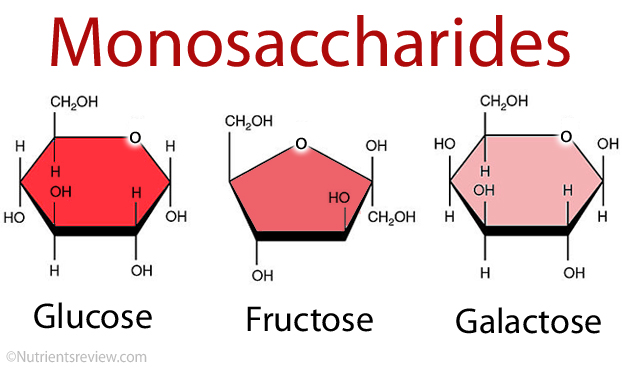- The monosaccharide definition Biology Online
- Carbohydrates, including simple sugars are non-essential nutrients National Academics Press
- A list of sugars and sweeteners Boston University
- Examples of rare sugars Raresugars.net
Monosaccharides or Simple Sugars
What are monosaccharides or simple sugars?
Monosaccharides [Greek monos = single; sacchar = sugar] or simple sugars consist of one sugar unit that cannot be further broken down into simpler sugars [1]. Examples of monosaccharides in foods are glucose, fructose and galactose.
Picture 1. Monosaccharide examples:
glucose, fructose and galactose.
Monosaccharides are the simplest form of carbohydrates. They can join together and form complex carbohydrates, for example: 2 monosaccharides form disaccharides, 3-10 of them form oligosaccharides and 11 or more of them form polysaccharides.
Functions
Monosaccharides are an energy source; most of them provide about 4 Calories (kilocalories) per gram, just like other carbohydrates. Glucose is the main fuel for the body cells. Fructose participates in metabolism. Galactose is found in erythrocytes of individuals with B-type of blood. Ribose is part of deoxyribonucleic acid (DNA) in the chromosomes.
Monosaccharides are non-essential nutrients, which means your body can produce all of those it needs for proper functioning from other nutrients, so you do not need to get them from food [2].
Absorption of Monosaccharides and Their Effect on Blood Sugar Levels
Monosaccharides, like most nutrients are absorbed in the small intestine. They can be absorbed without previously being broken down by the intestinal enzymes. Glucose and galactose are absorbed easily, completely and faster than other carbohydrates, while fructose can be absorbed slowly and incompletely.
After ingestion, glucose and galactose quickly raise the blood sugar (they have high glycemic index), while fructose raises blood sugar only mildly and slowly (it has low glycemic index).
During digestion, all carbohydrates have to be broken down into monosaccharides in order to be absorbed.
D- and L- Forms
Monosaccharides can appear in either D- (dextro) or L- (levo) form, which are the mirror images of each other. Most naturally occurring monosaccharides are in the D-form and most synthetically produced are in the L-form. D- and L- forms have different properties.
Picture 2. D- and L-erythrose with a mirror arrangement of atoms
(source: Wikimedia)
A List of Monosaccharides That Appear as Nutrients
Common Naturally Occurring Monosaccharides
- Glucose or dextrose
- Fructose
- Galactose
- Mannose
- Ribose and deoxyribose
All above monosaccharides are hexoses — they contain 6 carbon atoms.
Examples of Semi-Artificially Produced Monosaccharides (a Non-Complete List):
- Hexoses (contain 6 carbons):
- D- and L-allose
- D- and L-altrose
- D- and L-fucose
- D- and L-gulose
- D-sorbose
- D-tagatose
- Pentoses (contain 5 carbons):
- D- and L-arabinose
- D- and L-lyxose
- Rhamnose
- D-ribose
- Ribulose and its synthetic form sucroribulose
- D-xylose or wood sugar
- Tetroses (contain 4 carbons):
- D- and L-erythrose
- Erythrulose
- D- and L-threose
Above monosaccharides are usually synthetically produced from naturally occurring monosaccharides.
References: Boston University [3], Raresugars.net [4]
Examples of Foods That Contain a Lot of Free Monosaccharides
- Fruits and fruit juices (glucose, fructose)
- Honey (glucose, fructose)
- Candies (glucose)
- Syrups: liquid glucose; corn syrup and invert sugar (glucose and fructose); fructose syrup, high fructose corn syrup (HFCS), agave nectar and blackstrap molasses (high in fructose)
- Sweet wines (glucose, fructose)
- Foods with added simple sugars: soft drinks, sport drinks, energy drinks, liquers, chocolate, sweetened dairy products, desserts (mainly glucose)
Added Sugars
Sugars added to commercial foods are usually simple sugars: glucose (often named dextrose), fructose, high fructose corn syrup and invert sugar (a mixture of glucose and fructose).
Frequently Asked Questions
1. Are starch and glycogen monosaccharides?
No, starch and glycogen are polysaccharides composed of thousands of molecules of glucose, which is a monosaccharide.
2. Are sucrose and lactose simple sugars?
No, sucrose and lactose are sugars, but not simple sugars. They are disaccharides composed of two monosaccharides. Only monosaccharides are called simple sugars.
3. Which is the sweetest monosaccharide?
Fructose.
Are sugar alcohols monosaccharides?
Sugar alcohols (polyols) are similar to monosaccharides or disaccharides but they are neither of them.
Carbohydrates
- Fructose
- Galactose
- Glucose
- Isomaltose
- Isomaltulose
- Lactose
- Maltose
- Mannose
- Sucrose
- Tagatose
- Trehalose
- Trehalulose
- Xylose
- Erythritol
- Glycerol
- Hydrogenated starch hydrolysates (HSH)
- Inositol
- Isomalt
- Lactitol
- Maltitol
- Mannitol
- Sorbitol
- Xylitol
- Fructo-oligosaccharides (FOS)
- Galacto-oligosaccharides (GOS)
- Human milk oligosaccharides (HMO)
- Isomalto-oligosaccharides (IMO)
- Maltotriose
- Mannan oligosaccharides (MOS)
- Raffinose, stachyose, verbascose
- SOLUBLE FIBER:
- Acacia (arabic) gum
- Agar-agar
- Algin-alginate
- Arabynoxylan
- Beta-glucan
- Beta mannan
- Carageenan gum
- Carob or locust bean gum
- Fenugreek gum
- Galactomannans
- Gellan gum
- Glucomannan or konjac gum
- Guar gum
- Hemicellulose
- Inulin
- Karaya gum
- Pectin
- Polydextrose
- Psyllium husk mucilage
- Resistant starches
- Tara gum
- Tragacanth gum
- Xanthan gum
- INSOLUBLE FIBER:
- Cellulose
- Chitin and chitosan
- FATTY ACIDS
- Saturated
- Monounsaturated
- Polyunsaturated
- Short-chain fatty acids (SCFAs)
- Medium-chain fatty acids (MCFAs)
- Long-chain fatty acids (LCFAs)
- Very long-chain fatty acids (VLCFAs)
- Monoglycerides
- Diglycerides
- Triglycerides
- Vitamin A - Retinol and retinal
- Vitamin B1 - Thiamine
- Vitamin B2 - Riboflavin
- Vitamin B3 - Niacin
- Vitamin B5 - Pantothenic acid
- Vitamin B6 - Pyridoxine
- Vitamin B7 - Biotin
- Vitamin B9 - Folic acid
- Vitamin B12 - Cobalamin
- Choline
- Vitamin C - Ascorbic acid
- Vitamin D - Ergocalciferol and cholecalciferol
- Vitamin E - Tocopherol
- Vitamin K - Phylloquinone
- Curcumin
- FLAVONOIDS:
- Anthocyanidins
- Flavanols: Proanthocyanidins
- Flavanones: Hesperidin
- Flavonols: Quercetin
- Flavones: Diosmin, Luteolin
- Isoflavones: daidzein, genistein
- Caffeic acid
- Chlorogenic acid
- Lignans
- Resveratrol
- Tannins
- Tannic acid
- Alcohol chemical and physical properties
- Alcoholic beverages types (beer, wine, spirits)
- Denatured alcohol
- Alcohol absorption, metabolism, elimination
- Alcohol and body temperature
- Alcohol and the skin
- Alcohol, appetite and digestion
- Neurological effects of alcohol
- Alcohol, hormones and neurotransmitters
- Alcohol and pain
- Alcohol, blood pressure, heart disease and stroke
- Women, pregnancy, children and alcohol
- Alcohol tolerance
- Alcohol, blood glucose and diabetes
- Alcohol intolerance, allergy and headache
- Alcohol and psychological disorders
- Alcohol and vitamin, mineral and protein deficiency
- Alcohol-drug interactions



16 Responses to "Monosaccharides or Simple Sugars"